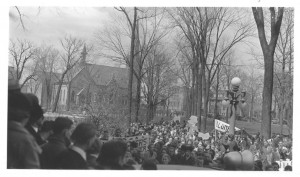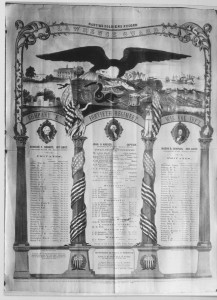Following the firing on Fort Sumter in April of 1861, Lawrence officials and Appleton community members called for a meeting in the chapel of Main Hall. In a speech delivered at the Lawrence semi-centennial celebration in 1897, Col. J.A. Watrous recalled the proceedings:
“I remember that President Mason presided; I remember that graduates and others from neighboring cities came to attend the meeting; I remember the speakers. The first was Professor Henry Pomeroy, a man great in mind and patriotism, but small of stature. The flag of the Union was there as we see it here. After a few words of introduction, Professor Pomeroy, pointing at the stars and stripes, said, and with a tremble in his voice: ‘If that flag goes down never to rise in honor again, it will be the greatest misfortune to civilization that has ever overtaken it.’ He then enumerated some of the many disasters that would follow the overthrow of the government of the United States. Drawing himself up to his full height, and throwing his head back, he again pointed to the flag and said: ‘Fellow citizens, I say to you that that flag shall not go down in disgrace. I say to you that the patriotism of the people of the North is such that every dollar and every man will be placed at the service of Abraham Lincoln in restoring peace.’ After this grand and patriotic flight there was an outburst by the audience that fairly made the building shake, well as it is founded. Such clapping of hands, stamping of feet and hurrahing were never before heard in Appleton. When quiet was restored, Professor Pomeroy, looking to heaven and raising his right hand, said: ‘I am not going to ask any of these people to go to the war, but I am going to ask some of them to come with me to the war.'”
This last line of Henry Pomeroy’s is the one most often repeated in contemporary accounts of this meeting. His speech and others “all bore fruit,” reported President Russell Z. Mason in a later recollection, in the form of “numerous enlistments.”

